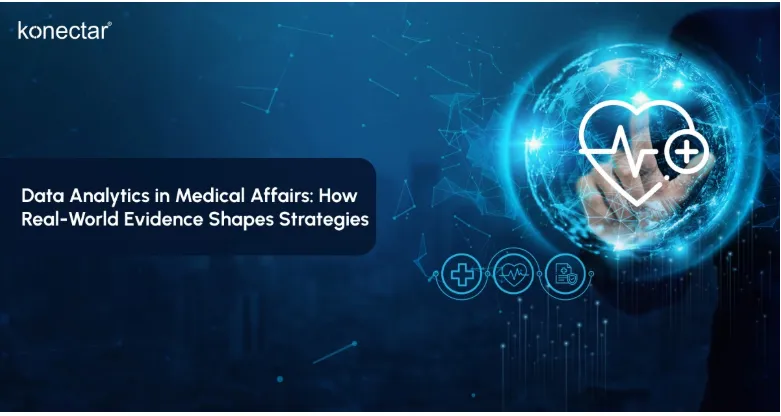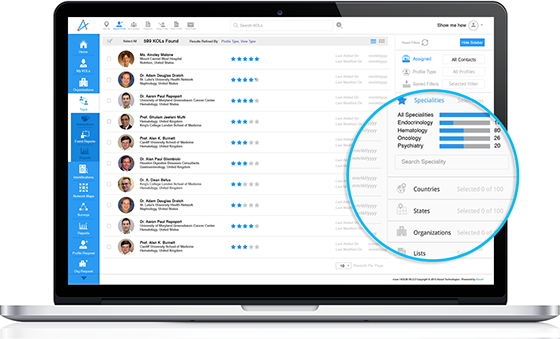22-05-2025
Data Analytics in Medical Affairs: How Real-World Evidence Shapes Strategies

How do new drugs perform once they hit the market? Are patients benefiting as expected from their treatments? These are some of the questions medical affairs teams are trying to answer using data, and lots of it. Data analytics in medical affairs has become a key driver in shaping healthcare strategies, especially with the rise of real-world evidence (RWE).
Unlike clinical trials, real-world data (RWD) shows what happens in everyday clinical settings. This data comes from electronic health records, insurance claims, patient surveys, and wearable devices. Medical affairs professionals analyze it to find insights that influence drug development, regulatory submissions, physician education, and patient care.
In this article:
The Growing Role of Data Analytics in Medical Affairs
Medical affairs has evolved from answering scientific questions to influencing the overall strategy of pharmaceutical companies. A key reason for this change is the ability to analyze complex healthcare data. With data analytics, medical affairs teams can:
⁕ Spot treatment gaps and unmet patient needs
⁕ Understand real prescribing patterns
⁕ Support meaningful discussions with healthcare professionals (HCPs)
This approach is powerful, especially when using RWD (Real-World Data), as it helps teams gather evidence on product value, safety, and effectiveness.
What is Real-World Data in Drug Development
Real-world data (RWD) refers to health-related information collected outside of traditional randomized clinical trials. This data originates from various sources, including electronic health records (EHRs), insurance claims and billing databases, patient registries, and digital health technologies like wearables and mobile apps.
RWD plays an increasingly vital role in drug development by providing insights that complement clinical trial data. It helps pharmaceutical companies and researchers to:
⁕ Design more targeted and practical clinical trials by understanding how diseases affect patients in everyday settings.
⁕ Identify unmet medical needs and optimize patient selection to improve trial relevance and success rates.
⁕ Support regulatory submissions and new drug indications by providing evidence of treatments' performance in diverse, real-world populations.
⁕ Monitor long-term safety and effectiveness of medicines after approval, beyond the controlled environment of clinical trials.
⁕ Inform health economics and outcomes research (HEOR) to demonstrate value to payers and healthcare systems.
Medical affairs professionals play a central role in analyzing this data and communicating the findings to inform strategy across the product lifecycle.
Real-World Evidence Applications in Medical Affairs
Real-World Evidence (RWE) is clinical evidence derived from analyzing Real-World Data (RWD) RWE provides insights on safety, effectiveness, and patient outcomes across diverse populations. It helps bridge the gap between what's proven in trials and what happens in clinics.
Medical affairs teams use RWE to produce publications, guide advisory boards, and back up claims about a drug's impact.
1. RWE and Its Role in Healthcare Decision-Making
RWE influences healthcare decisions at the clinical and regulatory levels. Agencies are increasingly open to using RWE to:
⁕ Approve new indications
⁕ Modify labeling
⁕ Monitor safety post-launch
For medical affairs teams, this means generating high-quality RWE that meets regulatory standards and provides meaningful, transparent insights.
2. Impact of RWE on Payer Decisions
It's not just regulators who care about RWE. Payers, hospitals, and even individual physicians use this type of evidence to make everyday decisions. With RWE, medical affairs can:
⁕ Help payers evaluate coverage and reimbursement
⁕ Support outcome-based pricing models
⁕ Provide physicians with data relevant to their patient populations
These insights also help pharmaceutical companies tailor their messages, educational materials, and engagement strategies more effectively.
3. Medical Affairs Insights from RWE
Medical affairs teams are increasingly expected to offer insights, not just information. RWE helps them:
⁕ Customize messages for different HCPs
⁕ Anticipate objections or questions based on real-world challenges
⁕ Find opportunities for new research or educational content
By distilling RWE into practical, relevant points, medical affairs builds trust and becomes a go-to partner for scientific and clinical guidance.
4. Post-Marketing Surveillance and RWD
After a product hits the market, the real test begins. Post-marketing surveillance using RWD is essential for:
⁕ Detecting rare side effects
⁕ Understanding usage in broader populations
⁕ Maintaining safety and compliance
Medical affairs works closely with pharmacovigilance teams to monitor and report these findings, supporting future product positioning and lifecycle planning.
5. RWE in Clinical Practice and Pharma Strategy
Real-world evidence isn't just for regulators and payers; it also supports healthcare professionals in their day-to-day clinical practice. Medical affairs uses RWE to:
⁕ Influence treatment guidelines
⁕ Identify educational gaps
⁕ Support practice-changing conversations
In pharma strategy, RWE helps prioritize which products to develop, which indications to pursue, and where to invest resources for maximum impact.
6. RWE in Regulatory Decisions
The growing acceptance of RWE in regulatory affairs circles is changing how drugs are evaluated. Medical affairs teams must ensure their RWE studies are methodologically sound, transparent, and aligned with regulatory expectations.
Conclusion
Real-world evidence is changing the way healthcare decisions are made, and data analytics makes this possible. Medical affairs teams are uniquely positioned to lead this transformation by extracting, analyzing, and communicating insights from real-world data.
Whether supporting clinical decisions, influencing payers, or shaping regulatory strategies, data analytics in medical affairs is helping turn information into impact.
FAQs
- How does Real-World Evidence (RWE) differ from clinical trial data?
While clinical trials provide controlled, specific insights about a drug’s safety and efficacy, RWE reflects how the drug performs in the broader, more varied patient populations in real healthcare settings.
- Why is RWE important for medical affairs teams?
RWE gives medical affairs teams a deeper understanding of a drug’s real-world impact. It helps them communicate better with healthcare professionals, support regulatory decisions, and tailor education and engagement efforts.
- Can RWE influence regulatory decisions?
Yes, regulatory agencies are increasingly accepting RWE to support approvals, expand drug indications, and monitor safety after a drug is on the market.
- How does RWE benefit patients?
RWE helps ensure treatments are effective and safe for diverse groups of patients. It also guides the development of better therapies that meet real patient needs.
- Is RWE only useful after a drug is approved?
No, RWE is valuable throughout a drug’s lifecycle, from helping design better clinical trials to supporting post-marketing surveillance and guiding future product development strategies.





